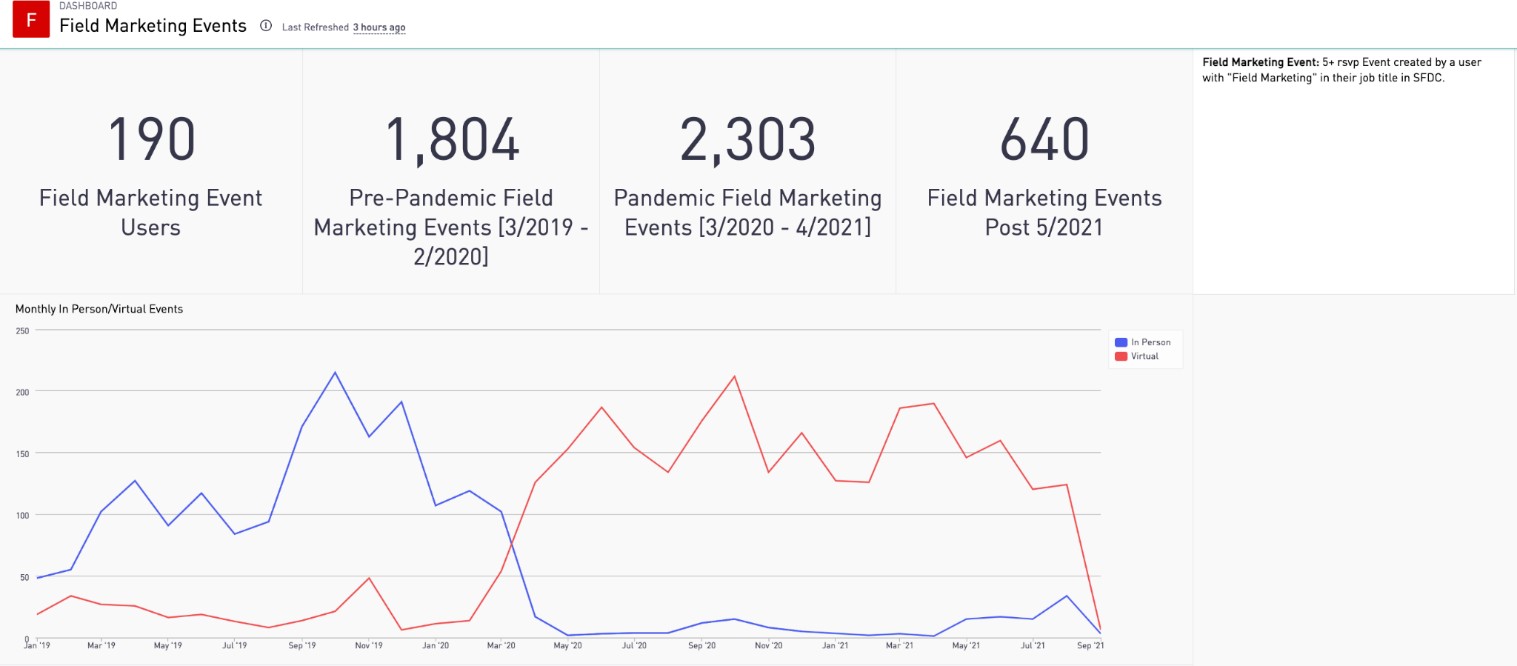Field marketers are highly trained professionals who engage in a wide range of activities that have a considerable and direct impact on revenue. Field marketers help build brands, manage customer relationships, and generate new leads. They also wear many hats, switching between sales, marketing and customer service functions hour by hour, creating critical links between those teams.
The types of partnerships, interactions, and relationships that field marketers build and leverage in their work varies by industry, so no two field marketers have the same job. Variations have been even starker during the pandemic when field marketers had to rethink how they approached their responsibilities overnight. No one’s role changed so dramatically and rapidly as field marketers’ roles. Yet, they continued to generate lead pipelines and engage with customers successfully, often with little recognition for the dedication and professionalism required.
But adversity breeds resilience, and the challenges of the last 18 months have illuminated new ways for field marketers to positively impact their companies and customers. By leaning on technology that facilitates collaboration and more accurate ROI tracking, embracing smaller virtual and hybrid events, and finding new ways to streamline their processes, field marketers have applied what worked during the pandemic to create integral new roles for themselves.
Marketing Technology News: Sensibill Named a Top Growing Company by The Globe and Mail for the Second Consecutive Year
Digital approaches to outreach and collaboration
To carry out their dynamic job successfully, field marketers must balance multiple responsibilities, from building brand awareness to enhancing customer experiences and relationships to providing measurable ROI. It’s no small feat. In any given week, a field marketer might go from taking on a supporting role in a sales meeting, hosting a session at a trade show, to conducting a demonstration during a roadshow or user event.
However, in the last year, the juggling act that field marketers have managed became a lot more complicated. While high-level goals are the same, the day-to-day tactics used to achieve those goals have changed according to the latest health and safety guidance and local restrictions. What was once a vibrant world full of in-person, live events and conferences where professionals could shake hands and make eye contact, field marketers have had to find new ways to foster relationships while often confined to their living rooms, kitchens and bedrooms. Remote work setups also made coordination and collaboration between field marketers and sales teams more difficult.

Our data shows one example of just how dramatic the shift to all-digital-everything has been for field marketers. In just a few days between March and April of 2020, the number of in-person field marketing events hosted on the Splash platform fell to nearly zero, while the number of virtual events increased tenfold. This total reversal was emblematic of the disruptions that marketers had to deal with in a short time.
Although adapting on the fly like that was challenging, it also opened the door for innovation and new ideas on creating, maintaining, and growing connections in out-of-the-box ways. For example, this same data shows that field marketers are relying more, not less, on events in the post-pandemic period. Over 600 field marketing events were hosted on the Splash platform in the four months after May 2021, a 7% increase over the number of events held during a comparable period in 2019. Field marketers have found that they can leverage the inherent advantages of virtual events, such as quickly replicating content and online event experiences and re-using marketing assets.
Marketing Technology News: MarTech Interview with Phil Gray, Chief Innovation Officer at Interactions LLC
Smaller events, bigger impact
Companies that once relied heavily on large-scale events have learned that smaller virtual field marketing events can improve both attendance and ROI. In fact, smaller events experience almost twice the attendance rates as their super-large counterparts. Smaller events are also better at getting decision-makers together in relevant, targeted situations, promoting engagement and yield real business results. While large in-person events can be inflexible and anonymous, small events are more agile, quicker to execute, and generate more measurable results.
Field marketers have used the digital tools they adopted during the pandemic to continue executing small-scale virtual and hybrid events. Those tools improved considerably during the pandemic and now provide a reliable way for field marketers to engage their clients and prospects without the need for traditional in-person interactions. They also help field marketers track attendee interactions and event activity, which they probably used to do a lot more informally.
Simplify and streamline
Like many professionals, the pandemic forced field marketers to do more with less. The annual industry conference that was a centerpiece of the marketing calendar? Field marketers replaced it with a series of smaller virtual gatherings. Sales teams and clients all working remotely and on modified schedules? Field marketers turned to digital collaboration tools to keep stakeholders aligned and ensure event processes ran smoothly. Fewer resources available to meet the same sales goals? Field marketers found ways to streamline and simplify while still generating pipeline and delivering ROI.
While the playing field looks considerably different from a pre-COVID world, field marketers have stepped up their game. They took what worked during the pandemic – smaller events, advanced event tech tools, virtual interactions – and expanded their playbook. These adaptations and innovations may have come from necessity, but field marketers have embraced them as the foundation for future success. And as the field marketer’s role evolves amidst all these changes, the lessons they’ve learned during the last 18 months will inform their new strategies and tactics and continue redefining their importance within every organization.
Marketing Technology News: Audience Targeting in Local Media Markets: More Than a Sum of Its Parts


